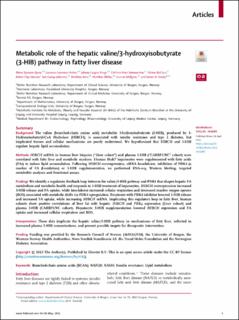Metabolic role of the hepatic valine/3-hydroxyisobutyrate (3-HIB) pathway in fatty liver disease
Bjune, Mona Synnøve; Dyer, Laurence; Laupsa-Borge, Johnny; Sommersten, Cathrine Horn; McCann, Adrian; Glastad, Robert Clay; Johnston, Iain; Kern, Matthias; Blüher, Matthias; Mellgren, Gunnar; Dankel, Simon N
Journal article, Peer reviewed
Published version

View/
Date
2023Metadata
Show full item recordCollections
- Department of Clinical Science [2295]
- Registrations from Cristin [9489]
Abstract
Background: The valine (branched-chain amino acid) metabolite 3-hydroxyisobutyrate (3-HIB), produced by 3-Hydroxyisobutyryl-CoA Hydrolase (HIBCH), is associated with insulin resistance and type 2 diabetes, but implicated tissues and cellular mechanisms are poorly understood. We hypothesized that HIBCH and 3-HIB regulate hepatic lipid accumulation.
Methods: HIBCH mRNA in human liver biopsies (“Liver cohort”) and plasma 3-HIB (“CARBFUNC” cohort) were correlated with fatty liver and metabolic markers. Human Huh7 hepatocytes were supplemented with fatty acids (FAs) to induce lipid accumulation. Following HIBCH overexpression, siRNA knockdown, inhibition of PDK4 (a marker of FA β-oxidation) or 3-HIB supplementation, we performed RNA-seq, Western blotting, targeted metabolite analyses and functional assays.
Findings: We identify a regulatory feedback loop between the valine/3-HIB pathway and PDK4 that shapes hepatic FA metabolism and metabolic health and responds to 3-HIB treatment of hepatocytes. HIBCH overexpression increased 3-HIB release and FA uptake, while knockdown increased cellular respiration and decreased reactive oxygen species (ROS) associated with metabolic shifts via PDK4 upregulation. Treatment with PDK4 inhibitor lowered 3-HIB release and increased FA uptake, while increasing HIBCH mRNA. Implicating this regulatory loop in fatty liver, human cohorts show positive correlations of liver fat with hepatic HIBCH and PDK4 expression (Liver cohort) and plasma 3-HIB (CARBFUNC cohort). Hepatocyte 3-HIB supplementation lowered HIBCH expression and FA uptake and increased cellular respiration and ROS.
Interpretation: These data implicate the hepatic valine/3-HIB pathway in mechanisms of fatty liver, reflected in increased plasma 3-HIB concentrations, and present possible targets for therapeutic intervention.
